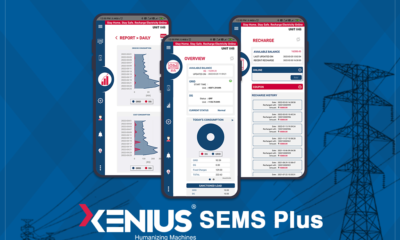News
SMNP: An essential programme replete with many challenges


Source:https://www.xenius.in/smnp-an-essential-programme-replete-with-many-challenges/
The Energy Efficiency Services Limited, tasked with implementing the Government’s ambitious Smart Meter National Programme (SMNP), faces an uphill task in creating an Advanced Metering Infrastructure (AMI) because of the multiple challenges involved. Yet, once implanted, the SMNP will go a long way in ensuring an efficient power management system in the country.
The Smart Meter National Programme (SMNP) is an initiative by the Government to replace 25 crore conventional meters in the county with smart meters. Under this programme, the Energy Efficiency Services Limited (EESL), a joint venture of four PSUs under the Ministry of Power, has already installed over 14.9 lakh smart meters in Uttar Pradesh, New Delhi, Haryana and Bihar. SMNP dashboards have also been launched for the National Electric Mobility Programme and solar initiatives to monitor the real-time progress of these programmes and their impact in a transparent manner.
The implementing agency, EESL, was founded in 2009 by the Government of India as a joint venture between the National Thermal Power Corporation Limited (NTPC), Power Grid Corporation of India Limited (POWERGRID), Power Finance Corporation Limited and the Rural Electrification Corporation Limited (REC). EESL functions under the Ministry of Power as a super energy service company to enable consumers and industries to manage and control their energy needs through smart, energy-efficient solutions.
- EESL functions under the Ministry of Power as a super energy service company to enable consumers and industries to manage and control their energy needs through smart, energy-efficient solutions.
- With electricity demand in the country expected to rise by 79 per cent in the next 10 years, India is on the path of enhancing its energy production. It also needs to cut its AT&C losses.
- AMI is a two-way communication network between a smart meter and a control system which uses GPRS and cloud technology to manage and control the power consumption.
- AMI requires high capital cost for all the software and hardware components required to implement the SMNP. It is a complex system that needs both time and expertise.
With electricity demand in the country expected to rise by 79 per cent in the next 10 years, India is on the path of enhancing its energy production. It also needs to cut its Aggregate Technical and Commercial (AT&C) losses to below 12 per cent by next year, and below 10 per cent by 2027. Towards reaching this goal, the most significant step is achieving a Smart Grid, i.e. paving the way for Advanced Metering Infrastructure (AMI).
AMI is a two-way communication network between a smart meter and a control system which uses GPRS and cloud technology to manage and control the power consumption. AMI provides consumers with error-free data about their energy consumption and helps them make an informed decision about their energy consumption practices at homes and offices.
AMI is essential for improving the overall efficiency of the grid as it improves the accuracy of meter reading, detects power theft, enables quick response to power outages and eliminates the need for manual meter reading. If implemented properly, AMI can increase the billing efficiency by 75 pc to 100 pc and ensure revenue hike of power utilities by more than Rs 1 lakh crore by reducing their equipment and maintenance costs.
However, despite the slew of benefits that AMI provides, the road set out for its implementing agency EESL is not smooth and it is confronted with multiple challenges. First and foremost, the AMI requires high capital cost for all the software and hardware components required to implement the SMNP. It is a complex system that needs both time and expertise to get integrated with the system of every utility. Also, the AMI needs to be implemented as per the guidelines issued by the Central Electricity Authority (CEA) so as to ensure a common standard for every utility.
Despite all these issues, there is no doubt that once implemented successfully, the SMNP will provide the Discoms real-time power consumption by each consumer, help them predict and manage power consumption during peak hours and, thereby, lead to efficient power management in the country.
-



 News3 weeks ago
News3 weeks agoKW Delhi 6 Mall Onboards New Brands
-



 News4 weeks ago
News4 weeks agoManasum Senior Living Launches IKIGAI GOA, A Senior Living Community in North Goa, in collaboration with Prescon Homes
-



 News3 weeks ago
News3 weeks agoCommercial Realty Gets Tech Savvy: Fast Construction, Enhanced Convenience
-



 News2 weeks ago
News2 weeks agoGodrej Properties Sells Rs 3k cr+ Homes of Godrej Zenith, Gurugram, within 3 days
-



 News4 weeks ago
News4 weeks agoBridging India Divide: Top 5 Tier- 2 Cities to Focus On
-



 News4 weeks ago
News4 weeks agoMultipoint Connection – A Definite Boon
-



 News3 weeks ago
News3 weeks agoRBI’s Status Quo on Key Policy Rates to Help Maintain the Real Estate Growth Momentum, Say Industry Stalwarts
-



 News1 week ago
News1 week agoOlive Announces Dhruv Kalro as Co-Founder





























